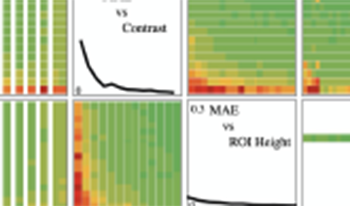
The edge-based Spatial Frequency Response (e-SFR) is an established measure for camera system quality performance, traditionally measured under laboratory conditions. With the increasing use of Deep Neural Networks (DNNs) in autonomous vision systems, the input signal quality becomes crucial for optimal operation. This paper proposes a method to estimate the system e-SFR from pictorial natural scene derived SFRs (NSSFRs) as previously presented, laying the foundation for adapting the traditional method to a real-time measure.In this study, the NS-SFR input parameter variations are first investigated to establish suitable ranges that give a stable estimate. Using the NS-SFR framework with the established parameter ranges, the system e-SFR, as per ISO 12233, is estimated. Initial validation of results is obtained from implementing the measuring framework with images from a linear and a non-linear camera system. For the linear system, results closely approximate the ISO 12233 e-SFR measurement. Non-linear system measurements exhibit scene-dependant characteristics expected from edge-based methods. The requirements to implement this method in real-time for autonomous systems are then discussed.

Contrast detection probability (CDP) is proposed as an IEEE P2020 metric to predict camera performance intended for computer vision tasks for autonomous vehicles. Its calculation involves comparing combinations of pixel values between imaged patches. Computation of CDP for all meaningful combinations of m patches involves approximately 3/2(m2-m).n4 operations, where n is the length of one side of the patch in pixels. This work presents a method to estimate Weber contrast based CDP based on individual patch statistics and thus reduces to computation to approximately 4n2m calculations. For 180 patches of 10×10 pixels this is a reduction of approximately 6500 times and for 180 25×25 pixel patches, approximately 41000. The absolute error in the estimated CDP is less than 0.04 or 5% where the noise is well described by Gaussian statistics. Results are compared for simulated patches between the full calculation and the fast estimate. Basing the estimate of CDP on individual patch statistics, rather than by a pixel-to-pixel comparison facilitates the prediction of CDP values from a physical model of exposure and camera conditions. This allows Weber CDP behavior to be investigated for a wide variety of conditions and leads to the discovery that, for the case where contrast is increased by decreasing the tone value of one patch and therefore increasing noise as contrast increases, there exists a maxima which yields identical Weber CDP values for patches of different nominal contrast. This means Weber CDP is predicting the same detection performance for patches of different contrast.